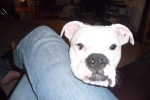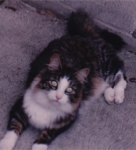Which size pillow pads?
Which size pillow pads?
I got my machine 1 week ago. I have struggled breathing with it on and ended up yanking it off in my sleep every night except one. They fitted me with the XS pillow pads and it felt good in the office and sealed nicely but when I am trying to sleep it is a struggle. So tonight I tried the small, it feels better but doesn't seal and air does escape. So I don't know if I should stick with the extra small and get use to it or let air escape and not feel like I am suffocating.
Also not sure if it matters but my setting is really low starts at 5 and ramps to 7.
Any advice is appreciated.
Also not sure if it matters but my setting is really low starts at 5 and ramps to 7.
Any advice is appreciated.
_________________
| Mask: AirFit™ P10 For Her Nasal Pillow CPAP Mask with Headgear |
| Humidifier: S9™ Series H5i™ Heated Humidifier with Climate Control |
| Additional Comments: Software resmed S9 wireless |
Re: Which size pillow pads?
When you say "it is a struggle", with the XS size nasal pillows, what are you struggling with? Sleeping? Leaks? It isn't clear to me if you're getting leaks with the XS or not.
I'd suggest a few things:
1. Try to fit the headgear when you're lying down as you would be sleeping. I know that the P10 isn't the kind of fit where you adjust the length of the straps, but you can find out about where you need to put the straps to get lowest leaks and most comfort before you need to actually use it. You can also try different sizes when you're not sleeping and see which works best for you when your body moves. I'm a side sleeper, and I find that lying in bed in my normal sleeping positions, and rolling around/over when I'm not sleeping is very helpful when I'm checking how a mask is fitting. That's how I figured out where the straps should go on the P10 for me when I'm sleeping.
2. If you're having problems with getting used to sleeping with the mask on, which could be the problem with the XS, then a couple of things might help...you could try using the mask when you're not sleeping, like when you're reading or watching TV, or something stationary, just to get used to using the mask, and getting familiar and comfortable with it. The other is to use a sleep aid like Ambien (if you can) to help you get to sleep at first. I did that for about a week, and when I stopped using Ambien my body had gotten used to going to sleep with all the gear on. Really helped.
3. Earplugs can be helpful when you're sleeping. Then about all you'll hear (assuming that you're not having major leak problems) is the sound of your breathing. I sleep with earplugs every night, and it really is helpful for me. I was using earplugs before cpap since I'm a light sleeper, but it is really helpful with the cpap machine going.
Anyways, getting this to work is just a process of trying different things until you find the best combination for you. At some point, looking at your sleep data will be helpful in fine tuning your cpap settings, but it doesn't sound like you're quite there yet *smile*. Hang in there, it will get better if you work with it.
I'd suggest a few things:
1. Try to fit the headgear when you're lying down as you would be sleeping. I know that the P10 isn't the kind of fit where you adjust the length of the straps, but you can find out about where you need to put the straps to get lowest leaks and most comfort before you need to actually use it. You can also try different sizes when you're not sleeping and see which works best for you when your body moves. I'm a side sleeper, and I find that lying in bed in my normal sleeping positions, and rolling around/over when I'm not sleeping is very helpful when I'm checking how a mask is fitting. That's how I figured out where the straps should go on the P10 for me when I'm sleeping.
2. If you're having problems with getting used to sleeping with the mask on, which could be the problem with the XS, then a couple of things might help...you could try using the mask when you're not sleeping, like when you're reading or watching TV, or something stationary, just to get used to using the mask, and getting familiar and comfortable with it. The other is to use a sleep aid like Ambien (if you can) to help you get to sleep at first. I did that for about a week, and when I stopped using Ambien my body had gotten used to going to sleep with all the gear on. Really helped.
3. Earplugs can be helpful when you're sleeping. Then about all you'll hear (assuming that you're not having major leak problems) is the sound of your breathing. I sleep with earplugs every night, and it really is helpful for me. I was using earplugs before cpap since I'm a light sleeper, but it is really helpful with the cpap machine going.
Anyways, getting this to work is just a process of trying different things until you find the best combination for you. At some point, looking at your sleep data will be helpful in fine tuning your cpap settings, but it doesn't sound like you're quite there yet *smile*. Hang in there, it will get better if you work with it.
_________________
| Machine: ResMed AirSense™ 10 AutoSet™ CPAP Machine with HumidAir™ Heated Humidifier |
| Mask: ResMed AirFit N30 Nasal CPAP Mask with Headgear |
Re: Which size pillow pads?
Try an even larger pair (medium) because it sounds like you have room to leak around what you're using now.
Re: Which size pillow pads?
I find the P10 larger pillows open my nares and help me breathe so I agree - try medium or even large. Use the biggest ones you can...
_________________
| Mask: AirFit™ P10 Nasal Pillow CPAP Mask with Headgear |
| Humidifier: S9™ Series H5i™ Heated Humidifier with Climate Control |
| Additional Comments: Sleepyhead SW. NeilMed and Alkalol Nasal rinses. Veramyst. AutoPAP 11-20 cms. Started June '14, untreated AHI 31-38, with PAP around 1. |
Re: Which size pillow pads?
With the XS there is no leaking but I feel like I can not breath at all. I tried the small last night, at first it felt like it was leaking but once I figured out how to adjust the mask I felt better and actually made it through the night with it on. I may try the mediums tonight just to see but they felt really large when I was just putting them up to my nose.
Since having RIA on my thyroid 2 years ago I also suffer from Air hunger and gasp for breath a lot so that could be a big issue as well.
Since having RIA on my thyroid 2 years ago I also suffer from Air hunger and gasp for breath a lot so that could be a big issue as well.
_________________
| Mask: AirFit™ P10 For Her Nasal Pillow CPAP Mask with Headgear |
| Humidifier: S9™ Series H5i™ Heated Humidifier with Climate Control |
| Additional Comments: Software resmed S9 wireless |
Re: Which size pillow pads?
You might be more comfortable with the air if you turn off the ramp feature. That starting 5 cm pressure doesn't move much air and can feel rather stifling. So lower pressure and the small volume of air in the nasal pillows can feel like we are suffocating. We won't but it sure can feel like it.
_________________
| Machine: AirCurve™ 10 VAuto BiLevel Machine with HumidAir™ Heated Humidifier |
| Additional Comments: Mask Bleep Eclipse https://bleepsleep.com/the-eclipse/ |
I may have to RISE but I refuse to SHINE.
-
TyroneShoes
- Posts: 107
- Joined: Sun Sep 07, 2014 2:45 pm
Re: Which size pillow pads?
For what it is worth, if you hold the pads up to your nose, no hose, and breathe normally, you will see a difference with the small version (I do not have the X-small) in that it is simply harder to breathe through, probably because the smaller volume and closer measurements internally contribute to the venturi effect/bernouli's principle (can never keep those two straight). This makes sense; if you try to breathe through a tiny straw, that is harder than through a big fat straw, for the same reason.
This makes me think that going to the smaller size may also mean you might need a higher pressure, as this will decrease the pressure at the expense of wind speed.
I am only guessing, and not a physicist, of course. But this caused problems for me when I tried the smaller version, and I suspect my pressure to be too low already so I think that aggravated that.
This makes me think that going to the smaller size may also mean you might need a higher pressure, as this will decrease the pressure at the expense of wind speed.
I am only guessing, and not a physicist, of course. But this caused problems for me when I tried the smaller version, and I suspect my pressure to be too low already so I think that aggravated that.
_________________
| Mask: AirFit™ P10 Nasal Pillow CPAP Mask with Headgear |
| Humidifier: S9™ Series H5i™ Heated Humidifier with Climate Control |
| Additional Comments: SleepyHead on Mac OS, EPR at 3, no ramp |
Re: Which size pillow pads?
My experience was that the medium fit ok, minimal leaks, and I slept *ok* but I was having lots of nasal irritation. Folks here recommended I go up to a large (which, in all honesty, hurt my pride a bit as I've never thought of my nose as large!) What a difference!!! When I first put it on I felt a bit pig nosed, but once I got the headgear adjusted comfortably I found breathing so, soooo much easier. Also, until I tried the larger pillows I hadn't noticed there was a bit of a "whoosh" noise on inhale through the medium pillows. This was non-existent with the large, and it was so comfortable and I slept so soundly that I had to put my hand to my face when I woke up to make sure I had the mask ON!
_________________
| Mask: AirFit™ P10 For Her Nasal Pillow CPAP Mask with Headgear |
| Additional Comments: Backup/travel unit is an identical S9 AutoSet for Her w/Eson nasal mask |
Re: Which size pillow pads?
If your CPAP is set up correctly it should allow for mask type and find the right pressure irrespective of the pipe/pillow size. Is is set to Pillows as the mask type? I agree the ramp is bad if you get even slight starvation. My APAP runs at 10-20 and I love it when it kicks in and blows open my airways.
_________________
| Mask: AirFit™ P10 Nasal Pillow CPAP Mask with Headgear |
| Humidifier: S9™ Series H5i™ Heated Humidifier with Climate Control |
| Additional Comments: Sleepyhead SW. NeilMed and Alkalol Nasal rinses. Veramyst. AutoPAP 11-20 cms. Started June '14, untreated AHI 31-38, with PAP around 1. |
Re: Which size pillow pads?
Rica, dear, you may not have noticed it, but your nose reaches all the way down to the floor!!! I mean, I hadn't mentioned it because I figured you'd noticed, and... after all, it is charming on you.RicaLynn wrote:Folks here recommended I go up to a large (which, in all honesty, hurt my pride a bit as I've never thought of my nose as large!)
Get OSCAR
Accounts to put on the foe list: dataq1, clownbell, gearchange, lynninnj, mper!?, DreamDiver, Geer1, almostadoctor, sleepgeek, ajack, stom, mogy, D.H., They often post misleading, timewasting stuff.
Accounts to put on the foe list: dataq1, clownbell, gearchange, lynninnj, mper!?, DreamDiver, Geer1, almostadoctor, sleepgeek, ajack, stom, mogy, D.H., They often post misleading, timewasting stuff.
Re: Which size pillow pads?
Charming for a Snuffelupagus, perhaps, but I am decidedly sapiens...Rica, dear, you may not have noticed it, but your nose reaches all the way down to the floor!!! I mean, I hadn't mentioned it because I figured you'd noticed, and... after all, it is charming on you.
_________________
| Mask: AirFit™ P10 For Her Nasal Pillow CPAP Mask with Headgear |
| Additional Comments: Backup/travel unit is an identical S9 AutoSet for Her w/Eson nasal mask |
Re: Which size pillow pads?
Hi, I have to agree - often a size bigger pillow works even if it seems counter intuitive! I use the M in this mask and at times felt maybe I should use a larger -however I just needed a little more pressure ( long ago I turned off ramp due to air hunger)' even though I have used a S pillow in other designs. I find that the larger pillow allows for proper inflation, and therefore a better seal and allows for a good airflow! Keep experimenting, you will find out what works for you.
_________________
| Mask: AirFit™ P10 For Her Nasal Pillow CPAP Mask with Headgear |
| Additional Comments: Heated Tubing; mask sometimes is TAP PAP mask; now P10 nasal pillows; use Sleepyhead software |
APAP 9-12














